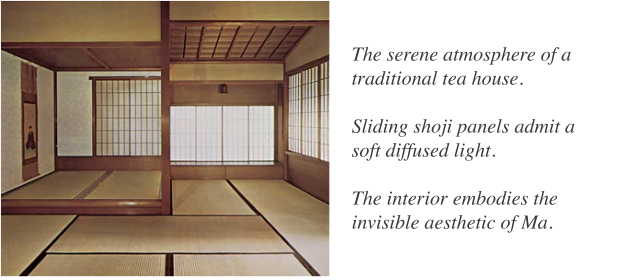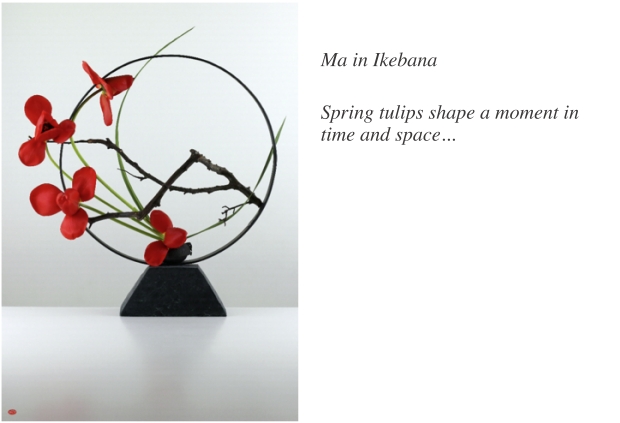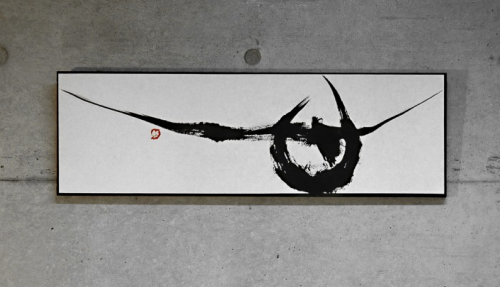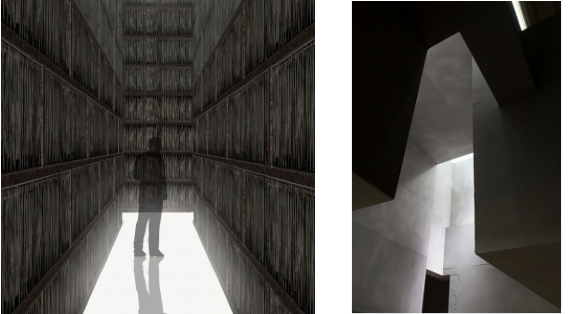Ma
|
The Japanese concept of Ma has been described as a pause in time, an interval or emptiness in space. Ma is the time and space life needs to breath, to feel and connect. If we have no time, if our space is restricted, we cannot grow. This universal principle applies to every aspect of life.
We can visually identify with the meaning of Ma from its Japanese kanji symbol.
Together these two characters depict a door through the crevice of which the sunlight peeps in.
We see in this symbol not only the structure of a door but a door that is open for the light to come in, thus enabling growth and sparking creativity. This is Ma – the space between the edges, the space and time in which we experience life.
Ma is filled with nothing but possibility. It speaks of silence as opposed to sound, of stillness and opposed to motion. It is the momentary pause in speech needed to convey meaningful words, the silence between the notes that makes the music…
In that stillness, free of noise, we connect on a soul level. There is a need for Ma in every aspect and every day of our lives. One of Britain’s most influential post war graphic designers, Alan Fletcher, refers to Ma in his introspective book The Art of Looking Sideways as an interval that gives shape to the whole.
“Space is substance. Cézanne painted and modelled space. Giacometti sculpted by “taking the fat off space”. Mallarmé conceived poems with absences as well as words. Ralph Richardson asserted that acting lay in pauses… Isaac Stern described music as “that little bit between each note – silences which give the form”… The Japanese have a word (ma) for this interval which gives shape to the whole. In the West we have neither word nor term. A serious omission.”
Travel writer Pico Iyer talks about the relevance of taking time to explore meaning through stillness in his insightful and beautifully presented TED Talk – The Art of Stillness.
Ma in Japanese culture
Nowhere is the concept of Ma more apparent than in Japan. Aesthetic values are deeply rooted in the mind-set of the people as a culture, interwoven throughout daily life. Decisions are carefully thought out, never rushed. Contemplative time and space is always considered. Intuition and feeling often determine the outcome of actions over pure logic and reasoning.
An everyday example of Ma can be seen in the respectful Japanese bow. People make a deliberate pause at the end of a bow before they come back up – the reason being, to ensure there is enough ‘Ma’ to convey feeling.
Another example would be the silent pause in conversation. The Japanese way of communication is full of emptiness, subjects of sentences are often left unsaid. Clarity in words is not always necessary, reaching an intuitive understanding in a silent pause is considered highly intelligent and sophisticated. This opposes the more direct western standards of communication, especially in the US where nothing should be left for speculation and conversations avoid the ‘awkwardness’ of silence.
In Japan, attentive listening and thoughtful observation are valued far more than pressing one’s opinion or speaking to simply fill an uncomfortable silence. In fact, silence is not perceived as uncomfortable at all. Quiet time is needed in order to truly think and feel the quality of an experience. Sincerity of feeling is often conveyed more effectively with a silent expression or gesture.
In the realm of Japanese society Ma is a sense of place in relation to the whole, often revealed in expressions or common phrases. For example, Ma-nuke, meaning fool, literally translates to ‘someone missing ma’. The term for human-being combines the kanji characters for ‘person’ and ‘place’ nin-gen (人間). We can see that a person is conceived of as part of a greater whole rather than separate. In many cases the western viewpoint differs, tending to envisage the human as a self-contained indivisible whole who should be educated to distinguish oneself from everyone else. These two social ideals are clearly opposed and frequently misunderstood.
Ma in traditional arts
Noh theatre is considered a supreme artistic expression of Ma, combining all aspects in a single refined performance. Senu tokoro ga omoshiroki is an expression the Japanese use to describe Noh theatre, meaning what the actor does not do is interesting. Noh epitomizes the dynamic balance between object and space, action and inaction, sound and silence, movement and rest. Former director of the Japan foundation New York, Isao Tsujimoto talks about the concept of Ma as an ‘intrinsic sense’ in Japanese culture, seen in all aspects of life, from the arts to every day conversation.
In the art of Ikebana, space is an essential component and often the focal point of an arrangement. It is viewed as ‘invisible energy’ that gives life to the form. Space is sculpted by the careful placement of materials.
When we step back to observe an arrangement, we feel the interplay between space and form. Ikebana reminds us to slow down, to shape our time and space not with things but with feeling.
|
|
In Japanese poetry Ma suggests a pause in time – it takes the mind to the moment that inspired the poet, suggesting that we contemplate that moment, experience it for ourselves. For example, the term ko-no-ma, meaning ‘among trees’ sets a vivid scene, yet at the same time the moment is open for individual interpretation.
In the art of sumi-e brush painting large areas of space are intentionally left unpainted. Proficiency lies not only in mastering the form of the characters, but also in the relationship between form and non-form. The dimension of time is key in the appreciation of sumi-e artwork. Traces of movement and the speed of the brush are valued as the marking of rhythm in time. Vast empty space enhances the energy that resides within every brush stroke.
Ma in architecture
In its architectural context Ma refers to the dimension of space between the structural posts of an interior. The layout is intentionally designed to encompass empty space – energy filled with possibilities.
The traditional tea house is a definitive example of Ma in architectural design. There are no decorative fixtures or ornaments. The structural walls alone set the foundation for life to perform. The emptiness of the interior enhances appreciation for the ephemeral experiences that pass through – the momentary gatherings of people and objects. This is a wonderful way to look at a home, free from material attachment, the walls are merely walls, it is about the life that occupies the space.
 In London 2014, The Royal Academy of Arts hosted a series of large scale interior installations centred around the concept to Ma. Japanese architect Kengo Kuma, along with some of the most creative architectual minds from around the world, utilized space and light to create sensory areas of space for viewers to experience.
Sensing Spaces: Architecture Reimagined.
As a philosophical concept Ma relates to our intrinsic need as humans to identify with purpose, to aspire and personify our lives. Ma is the space within which we exist, the space we appear from – the meaning is there to be discovered. |
Ma – in your life
The key point I would take away from the concept of Ma is to slow down and step back, feel and see from a whole perspective. Not only does this lead to personal growth, it reminds us that our actions play a role in shaping the world we share. This is ultimately where we find fulfillment.
Donna Canning






